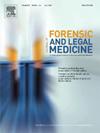神经退行性疾病的发现在芬兰神经病理学检查的法医尸检病例急性头部损伤
IF 1.2
4区 医学
Q3 MEDICINE, LEGAL
引用次数: 0
摘要
神经退行性疾病由于其不同的临床表现而提出诊断挑战,这强调了死后神经病理检查的重要性。随着年龄的增长,神经退行性疾病变得越来越普遍,它们会增加跌倒、事故和头部受伤的风险。我们的目的是,首先,报告芬兰急性头部损伤的神经病理学检查的法医尸检病例中神经退行性疾病的患病率;其次,报告最常见疾病实体中特定脑损伤的患病率、损伤情况和类型。我们分析了2016-2022年期间芬兰卫生和福利研究所法医部门赫尔辛基办事处的病例。病例包括疑似或确诊的头部损伤,并进行了神经退行性免疫组织化学的全面神经病理学检查。从死因调查文件和神经病理学报告中收集背景特征、神经退行性免疫染色和诊断以及头部损伤的数据。计算了神经退行性诊断的患病率,并提出了最常见疾病实体的头部损伤结果。在研究期间,共有128例疑似或确诊急性头部损伤的神经病理学检查病例。其中57例行神经退行性免疫组化,47例诊断为神经退行性。最常见的诊断为阿尔茨海默病神经病变(ADNPC) (n = 34)、脑血管病(CVD) (n = 34)和路易体病(LBD) (n = 9)。在任何神经退行性诊断的病例中,老年性头部损伤都很常见(36.2%)。在具体发现中,硬膜下出血和缺氧缺血性神经元损伤在ADNPC病例中绝对患病率最高,尽管ADNPC与CVD和LBD之间没有主要差异。总之,该数据集中最常见的神经退行性疾病实体是ADNPC、CVD和LBD。无论神经退行性实体如何,头部损伤史都是常见的。本文章由计算机程序翻译,如有差异,请以英文原文为准。
Neurodegenerative disease findings in Finnish neuropathologically examined medico-legal autopsy cases with acute head injuries
Neurodegenerative diseases present diagnostic challenges due to their diverse clinical presentations, which emphasizes the importance of postmortem neuropathological examination. As neurodegenerative diseases become more common with age, they contribute to a higher risk of falls, accidents and head injuries. Our aims were to, first, report the prevalence of neurodegenerative disease findings in Finnish neuropathologically examined medico-legal autopsy cases with acute head injuries and, second, report the prevalence, injury circumstances, and types of specific brain injuries in the most common disease entities. We analyzed cases from the Helsinki office of the Forensic Medicine Unit, Finnish Institute for Health and Welfare, over the period 2016–2022. Cases were included if they had a suspected or confirmed head injury, and underwent a full neuropathological examination with neurodegenerative immunohistochemistry. Data on background characteristics, neurodegenerative immunostains and diagnoses, and head injuries were collected from cause-of-death investigation documents and neuropathology reports. Prevalences of neurodegenerative diagnoses were calculated, and head injury findings were presented for the most common disease entities. During the study period, there were a total of 128 neuropathologically examined cases with suspected or confirmed acute head injuries. Neurodegenerative immunohistochemistry was performed in 57 of them, and a neurodegenerative diagnosis was established in 47 cases. The most prevalent diagnoses were Alzheimer's disease neuropathologic change (ADNPC) (n = 34), cerebrovascular disease (CVD) (n = 34) and Lewy body disease (LBD) (n = 9). Old head injuries were common among cases with any neurodegenerative diagnosis (36.2 %). Of specific findings, subdural haemorrhage and hypoxic-ischaemic neuronal injury had the highest absolute prevalence in cases with ADNPC, although there were no major differences between ADNPC, CVD and LBD. In conclusion, the most prevalent neurodegenerative disease entities in this dataset were ADNPC, CVD and LBD. A history of head injuries was common regardless of the neurodegenerative entity.
求助全文
通过发布文献求助,成功后即可免费获取论文全文。
去求助
来源期刊

Journal of forensic and legal medicine
MEDICINE, LEGAL-
CiteScore
2.70
自引率
6.70%
发文量
106
审稿时长
57 days
期刊介绍:
The Journal of Forensic and Legal Medicine publishes topical articles on aspects of forensic and legal medicine. Specifically the Journal supports research that explores the medical principles of care and forensic assessment of individuals, whether adult or child, in contact with the judicial system. It is a fully peer-review hybrid journal with a broad international perspective.
The Journal accepts submissions of original research, review articles, and pertinent case studies, editorials, and commentaries in relevant areas of Forensic and Legal Medicine, Context of Practice, and Education and Training.
The Journal adheres to strict publication ethical guidelines, and actively supports a culture of inclusive and representative publication.
 求助内容:
求助内容: 应助结果提醒方式:
应助结果提醒方式:


